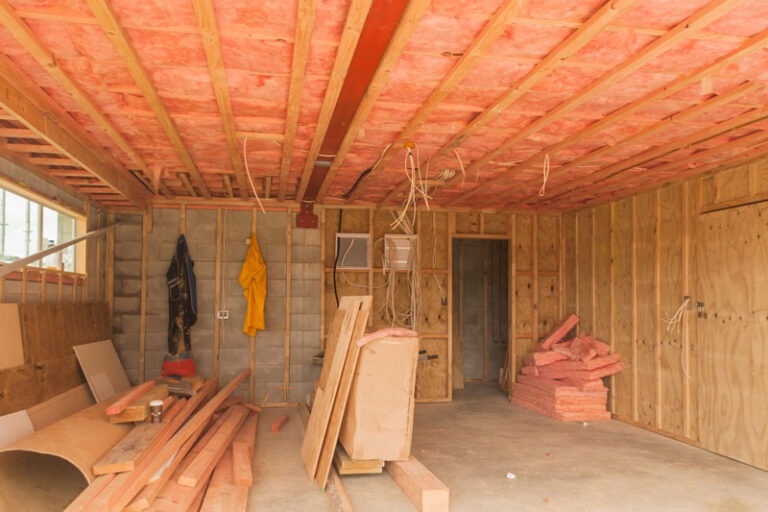Insulating a garage ceiling can significantly enhance energy efficiency, mainly when a room is directly above. Proper insulation helps maintain consistent temperatures, reduces energy costs, and improves comfort levels. If your garage is attached to or beneath a living space, addressing the ceiling insulation becomes crucial for both the functionality of the space below and the overall energy performance of your home. We will explore various methods and considerations on how to insulate garage ceiling with room above, ensuring both warmth in the winter and coolness in the summer.
Understanding the Importance of Insulation
When a room is above a garage, the garage’s ceiling is a critical barrier between the two spaces. Heat can easily escape from the room above into the garage without adequate insulation. Conversely, cold air from the garage can seep into the room. This exchange can lead to uncomfortable temperature fluctuations and increased energy consumption as heating and cooling systems work harder to compensate. Insulating the garage ceiling helps create a more stable environment in the garage and the room above. This enhances comfort and leads to more efficient energy use and lower utility bills. Understanding this principle is the first step in implementing an effective insulation strategy.
In addition to traditional insulation methods, incorporating a radiant barrier can significantly enhance energy efficiency, especially in garages with rooms above. For those in need of specific solutions, radiant barrier houston options offer a practical way to improve thermal performance and reduce energy costs in your home.
Choosing the Right Insulation Material
The choice of insulation material plays a vital role in the effectiveness of your insulation efforts. Several types of materials are commonly used, each with its advantages. Fiberglass batts are popular due to their ease of installation and cost-effectiveness. They fit between joists and provide an excellent thermal barrier. Alternatively, spray foam insulation offers superior air-sealing properties and can fill gaps and cracks, but it tends to be more expensive. Reflective or radiant barrier insulation is another option, especially useful in climates with extreme temperatures. It reflects heat away from the living spaces, which can be beneficial in maintaining comfortable temperatures. Evaluating the specific needs of your garage and room above will help determine the most suitable material.
Preparation and Installation Process
Before installing insulation, proper preparation is essential. Begin by inspecting the garage ceiling for issues like leaks or gaps. Address these problems before installing insulation to ensure the new material functions effectively. Using fiberglass batts, measure the spaces between the ceiling joists to cut the batts to the correct size. Place the batts between the joists, ensuring they fit snugly without compression. Professional application is often recommended for spray foam insulation to achieve the best results. Ensure the area is adequately ventilated during installation to allow the foam to cure correctly. Following these steps will help ensure that the insulation performs optimally.
Considerations for Ventilation
Proper ventilation is an important consideration when insulating a garage ceiling. If not adequately ventilated, insulation can trap moisture, leading to potential mold and mildew issues. Ensuring the garage has adequate airflow is essential to prevent these problems. Installing vents or incorporating ventilation systems can help maintain air quality and manage moisture levels. Sometimes, you might need to consult a contractor to assess the best ventilation solutions for your setup. Ensuring proper ventilation will safeguard the insulation’s effectiveness and protect the integrity of the garage and the room above.
Maintaining Insulation for Long-Term Efficiency
Once installed, insulation requires minimal maintenance, but it is essential to check its condition regularly. Over time, insulation can become compressed, damaged, or affected by moisture. Periodic inspections will help you identify and address any issues before they impact energy efficiency. If you notice any damage or reduced performance, take corrective actions such as repairing or replacing insulation sections. Proper upkeep ensures that the insulation continues functioning as intended, providing ongoing energy savings and comfort benefits.
Impact on Property Value
Improving the insulation of a garage ceiling can also positively affect your property’s value. Potential buyers often appreciate homes with enhanced energy efficiency, which signifies lower utility costs and a more comfortable living environment. A well-insulated garage, especially one with a room above, can make your home more attractive in a competitive real estate market. Additionally, effective insulation can reduce wear and tear on heating and cooling systems, which is an appealing factor for prospective buyers. By investing in quality insulation, you not only enhance the functionality and comfort of your home but also potentially increase its market value. This investment in your property can yield long-term benefits beyond immediate energy savings.
Insulating a garage ceiling is a strategic investment in improving energy efficiency, especially with a room directly above. Choosing the suitable materials, preparing properly, and considering ventilation can create a more comfortable and energy-efficient environment. Regular maintenance will help sustain these benefits over time, reducing energy costs and enhancing comfort in the garage and the room above. Implementing these insulation techniques will contribute to a more efficient and enjoyable living space, making the effort well worth it in the long run.
Keep an eye for more news & updates on Chicago Heading!

